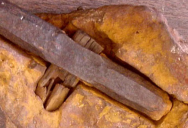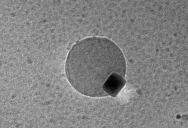Here’s Why The “London Hammer” Actually Proves Evolutionary Theory Is Correct

The world is full of mysteries and unexpected surprises, and they often come up in the least expected places.
One example of this is from London, Texas in 1936.
While on a walk, Emma and Max Hahn found a rock with a piece of wood sticking out of it, which struck them as odd, so they picked it up and brought it home.
Some years later, their son wanted to see what was inside the rock, so he broke it open to reveal that the piece of wood was actually the handle of a relatively modern hammer.

It has since been dubbed the London Hammer since it was found in London, Texas.
After this discovery, the Hahn’s talked about it in their community, which attracted the attention of Carl Baugh, who happened to be a young Earth creationist.
Not surprisingly, Baugh thought that this modern hammer encased in rock was proof that evolution was false.
When discussing the artifact, Baugh is known to have said:
“If the artifact is truly from the Cretaceous time frame, where does this leave evolutionary theory, since man was not supposed to have evolved for another 100-million years or so? If the artifact is relatively recent, that means that the Cretaceous Hensell Sand formation from which it came is relatively young… Again, where does that leave evolutionary theory with its traditional dates for the Cretaceous formations?”
These are certainly good questions, and if Mr. Baugh was right in all of his assumptions, this find would have certainly gone a long way to disprove evolution.

Of course, Mr. Baugh was not right in his assumptions and was really just betraying a simple ignorance of common geological processes.
In 1997, Glen J. Kuban published a paper on this hammer. In it, he said:
“The stone is real, and it looks impressive to someone unfamiliar with geological processes. How could a modern artifact be stuck in Ordovician rock? The answer is that the concretion itself is not Ordovician. Minerals in solution can harden around an intrusive object dropped in a crack or simply left on the ground if the source rock (in this case, reportedly Ordovician) is chemically soluble.”
This story is a good example of why it is so important to get a good understanding of a subject before assuming something disproves a widely accepted theory.
It is good to question everything, it will take strong proof to overturn the scientific consensus on any subject.
If you think that’s impressive, check out this story about a “goldmine” of lithium that was found in the U.S. that could completely change the EV battery game.

Sign up to get our BEST stories of the week straight to your inbox.




